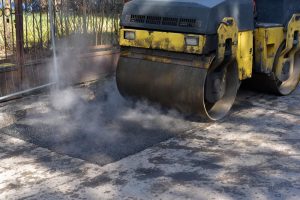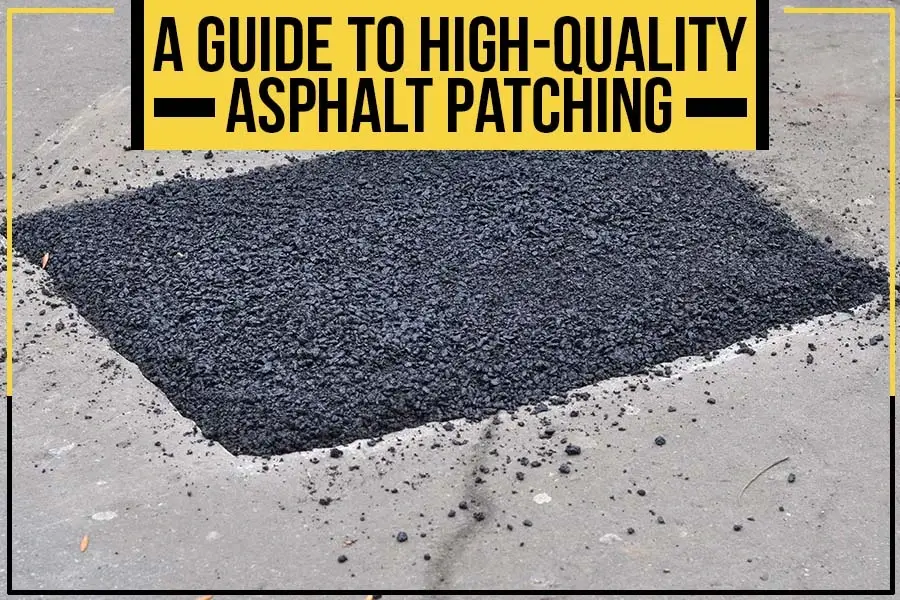Key Takeaways:
- Asphalt patching is a technique for repairing small parts of asphalt pavement by replacing degraded material with fresh asphalt to restore structural integrity without resurfacing or repaving.
- There are two types of asphalt filler: cold and hot. Cold filler is quick and easy to use but only lasts for a short time. Hot filler must be handled with care but will last longer.
- To patch effectively, start by gathering all necessary supplies and prep the area by removing debris and leveling the surface.
- Next, repair the foundation by filling it with a coarse gravel mixture an inch deep before applying the asphalt mix. Use a trowel or similar tool to spread it out evenly before allowing it to dry for 24 hours.
Asphalt patching is a frequently used method of asphalt repair. It is performed when asphalt pavement shows evidence of degradation, such as cracks, holes, or other issues that cannot be handled by simple chipping and resurfacing. If you are in charge of an asphalt parking lot or driveway, you must know the best asphalt patching procedures to keep your pavement in good shape!
In this blog post, Landmark will cover everything property owners and managers need to know about asphalt patching to keep their pavement in good shape.
Understanding Asphalt Patching:
Asphalt patching is a technique for repairing small parts of asphalt pavement by replacing degraded material with fresh asphalt to restore structural integrity without resurfacing or repaving.
Asphalt repair in your asphalt parking lot necessitates the usage of one of two materials. There are two options: cold asphalt filler and hot asphalt filler. Both can fill potholes, but learning their differences is crucial to select the right one for your asphalt surface problems.
Cold Asphalt Filler:
Cold asphalt filler, also known as the cold patch, is precisely what it sounds like. It is an asphalt patching substance that is not heated. Instead, it’s a substance that appears like asphalt since it’s made of the same components, including little particles of gravel that are dropped into the pothole from the container. The asphalt repairing filler is then tamped down to level up the surface.
Although cold asphalt patching filler is quick and easy to use, it is intended to last only a short time. This asphalt patching is considered a quick DIY fix and is typically used when the weather does not permit a more complex repair.
However, with recent advances in the asphalt sector, cold patching materials last longer and can be used in any weather.
Hot Asphalt Filler:
Hot asphalt filler is similar to ordinary asphalt, comprised of rock, sand, tar, and bitumen. It is put to the pothole while it is hot, and then heavy machinery compacts it to the surface, guaranteeing that it remains in place. Asphalt hot mix should be applied when temperatures are between 275-325 Fahrenheit, so it’s essential to factor in weather conditions before beginning your repair. Since hot asphalt must be maintained and handled with care, it is recommended to hire a professional.
How To Patch Asphalt?
Patching asphalt is a challenging task; it requires suitable materials and plenty of know-how. Here are all the steps necessary for a successful repair job.
Step 1: Gather Supplies
Before patching your asphalt, ensure you have all the necessary supplies. You’ll need an asphalt mix, a trowel, a rake, gloves, and safety goggles. You’ll also need to have a broom or blower handy for cleanup when the job is done.
Step 2: Prep the Area
Once you have all your supplies gathered and ready to go, it’s time to prep the area for repair. Start by removing loose material from the damaged area with a trowel or shovel. This step is crucial in ensuring that your patch sticks appropriately and lasts as long as possible. Once all the debris has been removed, use a rake to level out the edges of the repaired area so that it blends in evenly with its surroundings.
Step 3: Repair Foundation
Before fixing potholes, the foundation must be repaired. Fill the hole with a coarse gravel and sand mixture until it is an inch deep. As you fill, tamp and squeeze tightly. A sturdy foundation is required to fill a pothole effectively.
Step 4: Apply Asphalt Mix
Now that your surface is ready, it’s time to apply your asphalt mix. Start by pouring some of the mixes into the damaged area until it’s filled up completely. Use a trowel or similar tool to spread out and level the asphalt mix until everything looks smooth. Then use a broom handle or wood to tamp down on top of the surface for everything to set correctly. Allow 24 hours for everything to dry before taking any further steps.
Step 05: Finish with Seal Coating.
After the filler has cooled and hardened, apply a layer of asphalt sealcoating to the asphalt surface and prepare to paint any necessary lines after the sealcoating has cured.

Asphalt Patching Techniques:
Throw-And-Roll:
This is a quick patching procedure in which a hole is filled with liquid asphalt and rolled over. It is usually done in the winter or during bad weather when a “quick fix” or emergency patch is needed. It may be applied in layers and solidifies as it reacts with It may be applied in layers and hardens as it reacts with air.
Semi-Permanent Patches:
For a longer-lasting solution, appropriate surface preparation is required. Water and debris are removed using a broom or air compressor, and the patched area is trimmed back with a hand tool or power equipment. The patching mix is then applied to the prepared hole and compacted using a roller.
Spray Injection Method:
In this procedure, specialized truck-mounted equipment is utilized to blast off water and debris from the crack or pothole before injecting aggregate and emulsion into it. Compaction is not necessary because the injection is done at high pressure.
Full-Depth Patching:
This approach, considered a permanent repair procedure, entails digging the patching area to a depth of 4 inches and extending at least one foot into the surrounding region to give firmer support. A tack coat is put before the asphalt mix for appropriate bonding, followed by a backfill.
Final Thought:
You’re one step ahead of the game now that you know how to repair asphalt. You have no excuse for filling your asphalt parking lot with potholes or cracks.
Trust us!
Landmark, serving Deltona, provides a full range of asphalt repair services. Our crew is well prepared to tackle any asphalt repair task, from little potholes and cracks to large-scale patch jobs or full-depth restorations. We continuously strive to give high-quality services at reasonable pricing!





